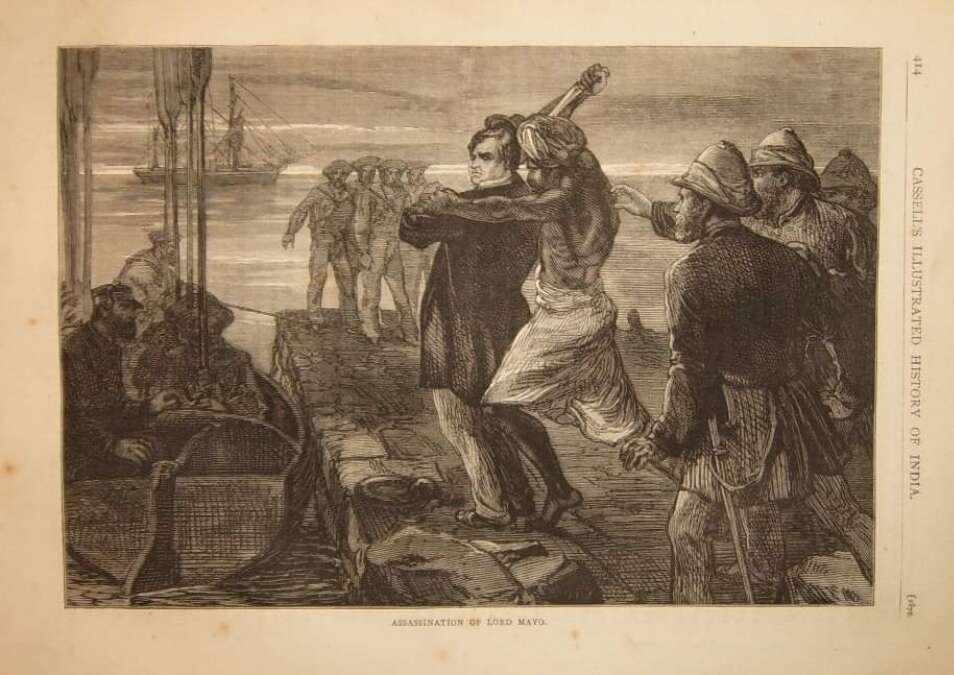Downsized existence
Owing to the ‘market policy’ of the penal colony, and superior treatment given to the ‘royal’ Eurasian and European prisoners, indigenous convicts were facing eventual decimation on the Andaman Islands

The next set of 22 inmates — the leaders of the Wahhabi movement and the loyal supporters of the royal family of Manipur — were transported in 1864. One of the Wahhabi leaders sent to the settlement, Sher Ali, fatally assaulted Viceroy Lord Mayo when he was returning after a pleasant trip to Mount Harriet on the evening of February 8, 1872. In what could only be described as ironic, just before the attack, Lord Mayo was heard saying that the place was ideal to hold at least two million people. Sher Ali was on a sick leave to Mount Harriet, and the evening before, he had thrown a dinner for his comrades and friends on the island. Later, investigations revealed that he was keeping abreast of the movement in the mainland.
After the first set of political inmates — those involved in the 1857 revolution, the Wahhabi movement and the Manipur rebellion — the penal settlement was opened to general convicts aged between 18 and 40, for the islands had the space and the British needed free labour to develop the settlement and maintain places like Ross Islands and Mount Harriet, which boasted of large spacious bungalows, club houses, dance halls and swimming pools. All this was built with the sweat, blood, and toil of the Hindustani prisoners.
However, even amongst the politicals, not all those who were sent to the islands retained the fervour of revolution. Some made 'intelligent compromises' and became part of the intermediary class that helped the superintendents of prisons in day-to-day tasks of administration. We have, for example, the interesting case of Maulana Muhammad Jaffar Thanesari, a Wahabi arrested in 1863 for conspiring to smuggle funds to anti-British mujahideen in Afghanistan. He was initially sentenced to death, but his punishment was commuted to life imprisonment in penal transportation, which meant exile in the Andaman Islands. Beginning 1866, he spent nearly 18 years in the penal colony, and then returned to Punjab with a new wife, children, and considerable wealth and social status. His status and utility in the penal colony was derived from his literacy in multiple languages — Urdu, Farsi, Hindi, and English. The work that Thanesari did in the penal colony demonstrated that punishment in the Andamans operated on a market principle of sorts. As the British needed loyal intermediaries at every level of the prison administration, they were obliged to bargain with convicts who might serve in such positions, and to reduce the punitive content of punishment.
In addition to men like Thanesari who were 'sent' to Andamans, the prison administration also sought 'volunteers' from amongst the Eurasian (Anglo Indian) convicts to assist them. In fact, soon after the establishment of the penal settlement, the British transferred Eurasian convicts in Indian and Burmese jails to the islands to work as convict- overseers. Eurasian prisoners from the mainland were offered remission after a three-year stay in the Islands, in addition to a stipend of Rs 50 per month. Prisoner skills included fluency in Hindustani, rope-, mat- and shoe-making as well as baking, carpentry and weaving. By 1867, there were as many as 34 Europeans, Eurasians and Americans employed as clerks, painters, fishermen and carpenters for 7,000 odd Hindustani prisoners. They were all clubbed together in the 'Christian barrack' where they relatively lived a life of luxury. Their barracks were stone-built, and some even had cubicles with beddings like the European soldiers. The Indian prisoners, on the other hand, were housed in wooden barracks — each holding 100 to 150 men, divided into groups of 25 each.
The living and working conditions for Indians were deplorable and sub-human, and in the 1870s, intense rain, malaria, pneumonia, and dysentery caused many deaths. Prisoners were also used as 'guinea pig' as doctors embarked on testing of pharmaceutical drugs like quinine (cinchona alkaloid) by forcibly feeding it to the 10,000 prisoners on the islands. Cinchona was a tree imported to Asia from Peru, whose bark would later be distilled to make quinine — an effective and natural anti-malarial drug. But the rough preparation and the dosage experimented with by the prison doctors caused acute side effects like nausea and diarrhoea. It was also used as a depressant. In monthly reports for the period of the test, the chief commissioner, Lieutenant-Colonel T Cadell, observed "a remarkable increase in suicides". Convicts "weary of life" were literally hacking each other to pieces, hoping to secure death penalty. But Cadell had a solution — "Flogging and a reduced diet." Everyone under the age of 22 was now required to sleep in "a sort of trellis-work cage".
Another fallout of the European presence was decimation of the indigenous population on account of sexual assault by soldiers and naval ratings. Later, measles, flu, tobacco, opium and whisky played their part in wiping out more than half of the indigenous population from the main island of Andamans in the 1870s.
After the Anglo-Manipur War in 1891, Manipur war-hero Yuvraj Tikendrajit and General Thangal were publicly hanged in Fida, Imphal, but Maharaja Kulachandra Dhwaja Singh and 22 freedom fighters were sent to Kalapani and kept on Mount Harriet. In October this year, the island was renamed as Mount Manipur. A memorial plaque for the Manipur heroes is now being put up by the Manipur government and the Island administration.
Views expressed are personal



